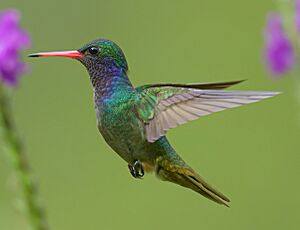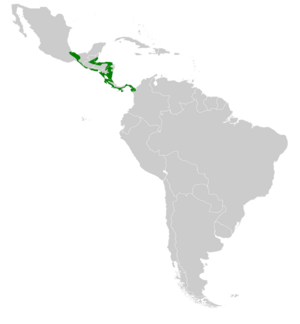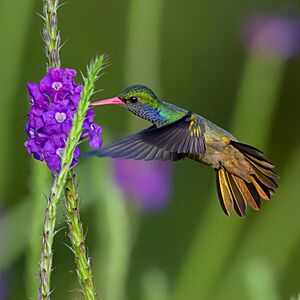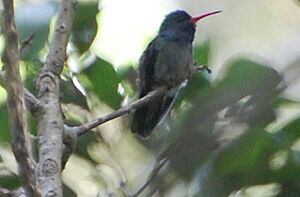Blue-throated goldentail facts for kids
Quick facts for kids Blue-throated goldentail |
|
|---|---|
 |
|
| At Arenal Observatory Lodge, Costa Rica | |
| Conservation status | |
| Scientific classification | |
| Genus: |
Chlorestes
|
| Species: |
eliciae
|
 |
|
| Range of H. eliciae | |
The blue-throated goldentail (Chlorestes eliciae) is a beautiful hummingbird. It's also sometimes called the blue-throated sapphire. This tiny bird lives in parts of Central America and South America. You can find it in countries like Mexico, Costa Rica, Panama, and Colombia.
These hummingbirds prefer to live in warm, wet forests. They also like areas where forests have been changed by people.
Contents
Meet the Blue-throated Goldentail
This hummingbird is a medium-sized bird. It measures about 9 cm (3.5 in) long. It weighs around 3.6 g (0.13 oz), which is less than a penny!
What Does It Look Like?
The male blue-throated goldentail is a bit bigger than the female. Both have bright, colorful feathers. Their main color is green on their heads and backs. This green often looks coppery or golden on their tails.
A special feature is their straight, bright red bill with a black tip. The male has a sparkling blue-violet throat. His belly is a creamy brown color. The sides of his chest and flanks have green streaks.
The female's throat is more violet-blue, mixed with gray. Her belly is lighter than the male's. Young birds look like the female, but their colors are not as bright.
How Do They Change?
When a young hummingbird hatches, its feathers change over time. This happens during its first year. For example, a young female's black bill slowly gets some red color. The greenish-blue spots on her throat become more blue.
Young males also change. Their bills become brighter red. The dark-blue spots on their throats get bigger.
Sounds and Songs
Male blue-throated goldentails sing to attract mates. They often sing in special gathering spots called "leks." Their songs can sound like "tseee" followed by short trills.
They also make calls, like a high, buzzing "tzip" or "tzet." When they are aggressive, they make a sharp, twittering sound. The fast flapping of their wings makes a "whirring" or "humming" sound.

Where Blue-throated Goldentails Live
These hummingbirds live only in the Americas. Their home stretches from southern Mexico down to western Panama. You can also find a few in northern Colombia.
They usually live in lowlands and valleys. They can be found at heights up to 950 meters (about 3,100 feet). Sometimes, they are seen even higher, up to 2,000 meters (about 6,500 feet). This might be because of climate change.
Their Home Environment
Blue-throated goldentails like different types of forests. This includes humid forests and forests that are growing back. They also live in plantations, open woodlands, and gardens. They are considered "resident" birds. This means they usually stay in the same area all year.
What Do Blue-throated Goldentails Eat?
Like most hummingbirds, the blue-throated goldentail mainly eats nectar. Nectar is a sweet liquid found in flowers. They feed from many types of flowers. These include flowers from shrubs like Stachytarpheta and Hamelia. They also eat from large plants like Heliconia.
Sometimes, they also eat small arthropods, like tiny insects. This gives them extra protein.
How They Raise Their Young
Not much is known about how blue-throated goldentails raise their babies in the wild. They are thought to breed during the dry season. This is usually between December and July.
Females build cup-shaped nests. They use plant materials and spider webs. These nests are often found on small branches. They are usually 2 to 4 meters (about 6 to 13 feet) high. Females typically lay two eggs.
Are They Safe?
The number of blue-throated goldentails seems to be growing. They live across a large area. Because of this, they are not considered a threatened species. They are listed as "Least Concern" by conservation groups. This means they are not in danger of disappearing.
Images for kids




